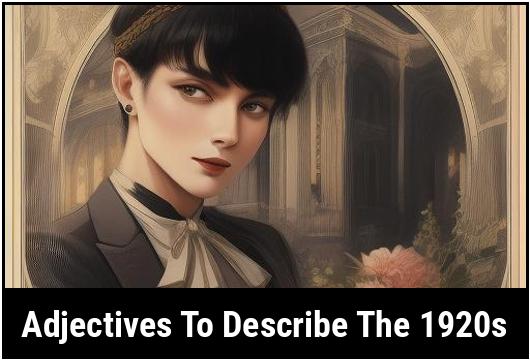- You are here:
- Home »
- adjectives
- » 31 Adjectives To Describe The 1920s

31 Adjectives To Describe The 1920s
The 1920s was a transformative and eventful decade that witnessed significant social, political, and cultural changes. This article explores the various adjectives that aptly describe this period, delving into the reasons for using adjectives, types of adjectives, and how to choose the right ones. Understanding the adjectives associated with the 1920s enables a more nuanced comprehension of this crucial era in history.
The 1920s, often referred to as the "Roaring Twenties," was a time of prosperity, cultural dynamism, and significant societal shifts. This decade was characterized by economic growth, technological advancements, and the rise of cultural phenomena such as jazz music, literature, and art. In addition, the 1920s also witnessed the prohibition of alcohol, the women’s suffrage movement, and unprecedented changes in fashion and lifestyle.
Key Takeaways
- The 1920s, known as the "Roaring Twenties," was a period of significant social, cultural, and economic change.
- It saw the emergence of jazz music, the prohibition of alcohol, advancements in technology, and the empowerment of women.
- Describing the 1920s using adjectives provides a nuanced understanding of the era’s characteristics and impact.
Adjectives To Describe The 1920s
1. Exhilarating
The 1920s were truly exhilarating, as society tumbled out of the restrictive Victorian era and embraced a newfound sense of freedom. This was a time when traditional values were challenged, fueling a sense of adventure and risk-taking.
2. Progressive
The 1920s saw remarkable progress in numerous domains, including politics, women’s rights, and civil rights. Social activism rose to the forefront as individuals strove to challenge existing norms and gain rights and equality for all.
3. Vibrant
With the advent of the Jazz Age, vibrant energy permeated the 1920s. From the lively music to the sparkling dance floors, this decade was alive with color, enthusiasm, and a lively spirit that resonated in all aspects of life.
4. Glamorous
From dazzling flapper dresses to extravagant parties, the 1920s were a golden age of glamour. Hollywood stars and high-society figures set the style standards, adorning themselves in opulent outfits and indulging in a life of luxury.
5. Innovative
The 1920s witnessed an explosion of innovation, particularly in technology and industry. Major advancements in engineering and manufacturing processes led to the widespread availability of consumer goods, transforming daily life for many.
6. Dynamic
This decade was marked by a dynamic atmosphere that encompassed all spheres of society. From the rapidly evolving urban landscape to the rise of industries and the shifting political climate, the 1920s embodied constant change.
7. Fast-paced
Thanks to technological advancements, the 1920s became a remarkably fast-paced era. Radio broadcasts, automobiles, and advances in communication meant that news, ideas, and trends were transmitted at unprecedented speeds.
8. Liberating
The 1920s brought about a sense of liberation, as individuals, especially women, pushed boundaries and sought new freedoms. This decade witnessed the rise of the flapper, a symbol of independence and non-conformity.
9. Transformative
The 1920s were a transformative period that altered the cultural and social fabric of society. From the way people dressed to their outlook on life, this decade brought about lasting changes that would reverberate throughout the rest of the 20th century.
10. Jazz-infused
As the Jazz Age, the 1920s marked a significant movement in music. Jazz, with its distinctive rhythms and improvisational nature, came to encapsulate the spirit of the era.
11. Prosperous
The 1920s represented a time of great prosperity in the United States. A booming economy, combined with technological advancements and increased industrial production, raised the standard of living for many Americans.
12. Modern
The 1920s ushered in a sense of modernity, as people embraced new ideas, fashion, and design. Art Deco became the architectural and artistic style of choice during this period, embodying sleek lines, geometric shapes, and a forward-looking aesthetic.
13. Hedonistic
The 1920s were characterized by a hedonistic pursuit of pleasure and indulgence. This was an era of carefree abandon, where people sought to escape the hardships and restrictions of the past and revel in the present.
14. Flamboyant
The 1920s were known for their flamboyant style, both in fashion and lifestyle choices. Bold colors, intricate beadwork, and feathered accessories defined the exuberant fashion trends of the decade.
15. Carefree
The 1920s introduced a sense of carefreeness and abandonment of societal constraints. This was a time when people embraced leisure activities, such as sports, dancing, and socializing, seeking respite from the gloom of the previous decade.
16. Magnetic
The 1920s were a magnet for creative minds, attracting artists, writers, and musicians seeking inspiration and artistic freedom. This cultural magnetism fueled a flourishing arts scene, producing some of the most iconic works of the century.
17. Daring
The 1920s were an era of daring, as people defied conventional norms and societal expectations. Whether through fashion choices, career pursuits, or political activism, individuals were unafraid to take risks and embrace their true selves.
18. Revolutionary
The 1920s heralded a revolution in various realms, including technology, politics, and culture. From the invention of the radio to the passage of women’s suffrage, this decade marked significant milestones in human history.
19. Confident
With newfound freedoms and economic prosperity, the 1920s were characterized by a sense of confidence and self-assuredness. People were willing to take on challenges and pursue their dreams, embracing a spirit of optimism and ambition.
20. Electrifying
Electricity became increasingly prevalent during the 1920s, transforming not only the way people lived their daily lives but also their leisure activities. The rise of cinema and electrified music provided electrifying entertainment to the masses.
21. Progressive
The 1920s were a progressive era, encapsulating a desire for social change and reform. This period witnessed significant advancements in civil rights, women’s suffrage, and labor rights, setting the stage for further progress in the decades to come.
22. Experimental
Expanding on the daring nature of the 1920s, this was a decade marked by experimentation. Whether in literature, art, or fashion, individuals were unafraid to explore new territories and challenge traditional conventions.
23. Roaring
The adjective "roaring" aptly describes the vibrant energy that defined the 1920s. The era was characterized by an exuberant spirit, with parties, flappers, and the lively sound of jazz occupying the cultural landscape.
24. Artistic
The 1920s witnessed a flourishing of artistic expression, with movements like Surrealism, Dadaism, and the Harlem Renaissance pushing boundaries and redefining artistic norms. It was a time of creative exploration that produced some of the most influential works in history.
25. Futuristic
The 1920s embraced a futuristic mindset, as advancements in technology and industry paved the way for a brighter future. People looked towards progress and innovation, anticipating a world that would be shaped by their vision.
26. Sophisticated
With its opulent fashion, thriving entertainment scene, and cultural renaissance, the 1920s exuded sophistication. This was a time when elegance and refinement were highly valued, not only in the upper echelons of society but also among the masses.
27. Liberated
The 1920s were an era of liberation, particularly for women. The passage of the 19th Amendment granting women the right to vote and the emergence of flappers symbolized a newfound freedom and independence for women.
28. Trailblazing
The 1920s were marked by many trailblazing individuals who challenged societal norms and pioneered new paths. From Amelia Earhart taking to the skies to Josephine Baker breaking barriers in the entertainment industry, these visionaries shaped history.
29. Progressive
The 1920s were a progressive era, encompassing changes that affected all aspects of society. The adoption and expansion of scientific knowledge, political movements, and social reforms pushed humanity towards a more inclusive and tolerant future.
30. Epoch-making
The 1920s left an indelible mark on history, making it an epoch-making decade. The societal shifts, unprecedented technological advancements, and cultural revolutions set the stage for the modern era that followed.
31. Unforgettable
The 1920s are a decade to remember, forever etched in the annals of history. The allure, vibrancy, and revolutionary changes that defined this period continue to captivate our imagination and spark a sense of nostalgia.
Why Use Adjectives To Describe 1920s
Adjectives play a crucial role in evoking the essence of historical periods. When used to describe the 1920s, adjectives help to capture the spirit, culture, and overall atmosphere of the era. They allow for a deeper understanding of the social, economic, and cultural landscape of the time. By employing adjectives, historians, scholars, and enthusiasts can paint a vivid and detailed picture of the 1920s, offering valuable insights into its impact on society and its lasting legacy.
How To Choose The Right Adjective To Describe 1920s
Selecting the appropriate adjectives to describe the 1920s requires a comprehensive understanding of the decade’s defining characteristics. It is essential to consider the various facets of the era, including social movements, technological advancements, cultural shifts, and the overarching mood of the period. Adjectives should encapsulate the vibrancy, dynamism, and complexity of the 1920s, reflecting its multifaceted nature. Additionally, adjectives must be chosen based on their ability to convey the essence of the era with accuracy and depth.
Types Of Adjectives For Describing 1920s
Cultural Adjectives
Cultural adjectives are instrumental in capturing the creative, artistic, and societal developments that took place during the 1920s. These adjectives illuminate the vibrant cultural landscape of the era, encompassing aspects such as literature, music, fashion, and visual arts. Examples of cultural adjectives include:
- Artistic: Reflecting the flourishing artistic expression and innovation during the 1920s.
- Jazzy: Emanating the spirit and rhythm of the jazz age that characterized the era.
- Bohemian: Signifying the unconventional and free-spirited artistic subculture of the time.
- Flapper: Representing the rebellious and fashionable young women who challenged traditional gender norms.
- Literary: Highlighting the significant literary achievements and influence of writers during this period.
Socio-Political Adjectives
Socio-political adjectives are pertinent in describing the societal and political climate of the 1920s, encompassing movements, reforms, and ideological shifts. These adjectives shed light on the social dynamics, political movements, and evolving ideologies that defined the era. Examples of socio-political adjectives include:
- Progressive: Illustrating the progressive social and political movements that sought reform and change.
- Suffragist: Referring to the advocacy for women’s suffrage and the empowerment of women.
- Rebellious: Signifying the defiance against societal norms and traditional values that characterized the era.
- Prohibitive: Relating to the prohibition of alcohol and the resulting societal implications.
- Transformational: Conveying the profound societal and political transformations that occurred during the 1920s.
Economic Adjectives
Economic adjectives are crucial in depicting the economic prosperity, consumer culture, and financial dynamics of the 1920s. These adjectives capture the economic boom, consumerism, and entrepreneurial spirit that defined the decade. Examples of economic adjectives include:
- Prosperous: Describing the economic affluence and prosperity that characterized the decade.
- Consumerist: Reflecting the rise of consumer culture and mass consumption of goods and services.
- Entrepreneurial: Signifying the spirit of innovation, business growth, and entrepreneurial pursuits.
- Materialistic: Indicating the emphasis on material wealth and possessions during this period.
- Boomtown: Emanating the rapid economic growth and urban development experienced in many areas during the 1920s.
The 1920s was a pivotal era marked by cultural dynamism, societal change, and economic prosperity. By employing a diverse array of adjectives, one can effectively capture the multifaceted nature of this transformative decade. Cultural adjectives evoke the artistic and creative fervor of the era, while socio-political adjectives highlight the progressive movements and ideological shifts. Additionally, economic adjectives portray the economic boom and consumerist trends that characterized the period. By understanding and utilizing these adjectives, we gain a richer and more comprehensive understanding of the 1920s and its enduring significance in shaping modern society.
Examples Of Adjectives For Different Types Of 1920s
The 1920s, commonly referred to as the "Roaring Twenties" or the "Jazz Age," marked a significant period of social and cultural transformation in the United States and many other parts of the world. This decade saw an unprecedented boom in many areas, including economy, technology, art, and fashion. To truly capture the essence of this vibrant era, it is important to use adjectives that accurately depict the characteristics and spirit of the 1920s.
Economic Prosperity
- Flourishing: The 1920s witnessed a flourishing economy, with rapid industrial growth and increased consumer spending.
- Prosperous: The decade was marked by a prosperous economy, characterized by rising wages and increased job opportunities.
- Booming: The economic boom of the 1920s led to a period of booming businesses and financial success for many.
Social And Cultural Changes
- Progressive: The 1920s were a time of progressive social and cultural change, challenging traditional norms and embracing new ideas.
- Liberal: This decade witnessed a liberal mindset, with a greater emphasis on personal freedom and the pursuit of individual desires.
- Modern: The 1920s ushered in a wave of modernity, with technological advancements and a break from traditional values.
Jazz And Music
- Jazzy: The 1920s were undeniably jazzy, blessed with the birth of this vibrant musical genre that defined the era.
- Rhythmic: The music of the 1920s was characterized by its lively and infectious rhythms, which became the soundtrack of the decade.
- Upbeat: The melodies that resonated in the 1920s were often uplifting and imbued with an energetic quality, creating a sense of optimism.
Art And Culture
- Avant-garde: The art and culture of the 1920s embraced an avant-garde spirit, challenging artistic conventions and pushing boundaries.
- Glamorous: This decade exuded a glamorous allure, as seen in fashion, art, and entertainment, through its opulent and extravagant style.
- Futuristic: The 1920s signaled a glimpse into the future, with its embrace of technological advancements and a forward-thinking approach.
Fashion And Style
- Flapper: The fashion of the 1920s revolutionized women’s attire with the introduction of flapper dresses, symbolizing a new found freedom and empowerment.
- Elegant: The fashion and style of the 1920s was often characterized by elegant and sophisticated designs, embracing simplicity and grace.
- Dapper: Men’s fashion in the 1920s emphasized a dapper aesthetic, with tailored suits, fedora hats, and polished shoes.
Common Mistakes In Using Adjectives To Describe 1920s
When describing the 1920s, it is crucial to avoid common mistakes that may inadvertently misrepresent the era. Here are some common pitfalls to watch out for:
Inaccurate Descriptions
One of the most common errors is using adjectives that are historically inaccurate or do not align with the spirit of the 1920s. For example, describing the era as "restrained" or "conservative" would not accurately capture the progressive and liberal atmosphere that prevailed during this time.
Overgeneralization
Another mistake is using broad adjectives that lack specificity and fail to capture the nuances of the era. Terms like "interesting" or "exciting" may be accurate to some extent, but they are too vague to fully convey the unique characteristics and vibrancy of the 1920s.
Ignoring Diversity
The 1920s encompassed a wide range of experiences and perspectives. Thus, it is essential to acknowledge the diversity within this era, both in terms of social class, race, and geographical location. Overlooking this diversity can lead to a one-dimensional portrayal of the 1920s.
Using Adjectives Effectively
To ensure accurate and compelling descriptions of the 1920s, consider the following tips:
Research And Context
Before using adjectives to describe the 1920s, it is important to have a comprehensive understanding of the historical context. Research the major events, social movements, and cultural developments of the time to accurately capture the spirit of the era.
Specificity And Detail
Rather than relying on generic adjectives, aim for specificity and detail in your descriptions. Use adjectives that vividly evoke the unique aspects of the 1920s, such as "exuberant," "innovative," or "revolutionary."
Imagery And Sensory Language
To truly transport your readers to the 1920s, incorporate sensory language and vivid imagery in your descriptions. Use adjectives that appeal to the senses, such as "sultry," "lively," or "sparkling," to convey the sights, sounds, and atmosphere of the era.
Consider The Audience
Keep in mind the audience you are addressing when selecting adjectives. If your readers are unfamiliar with the 1920s, it may be helpful to provide additional context in your descriptions to enhance their understanding and engagement.
Exercises And Practice
To strengthen your ability to describe the 1920s accurately and effectively, here are some exercises and practice prompts:
- Write a paragraph describing the economic prosperity of the 1920s, using at least three adjectives that illustrate the era’s prosperity.
- Create a character from the 1920s. Write a detailed description of their fashion and style, incorporating appropriate adjectives.
- Imagine you are attending a jazz performance in the 1920s. Write a sensory-rich paragraph describing the ambiance, music, and energy of the event, using adjectives that transport the reader to this era.
- Write a short dialogue between two individuals discussing the social changes and cultural shifts of the 1920s. Incorporate adjectives to convey their different perspectives and attitudes towards these changes.
Conclusion
The 1920s was an era defined by its exuberance, innovation, and cultural transformation. By selecting adjectives that accurately depict the various aspects of this decade, such as economic prosperity, social changes, music, art, and fashion, we can capture the essence and spirit of the 1920s. Through careful research, attention to detail, and usage of evocative language, we can transport ourselves and our readers back in time to experience the vivacity and vibrancy of the "Roaring Twenties" firsthand.
FAQS On Adjectives To Describe The 1920s
What Were Some Common Adjectives Used To Describe The 1920s?
Some common adjectives used to describe the 1920s include vibrant, dazzling, extravagant, optimistic, and roaring.
What Is The Significance Of The Term "roaring Twenties" In Describing The 1920s?
The term "roaring twenties" is significant in describing the 1920s because it captures the essence of the decade’s rebellious and carefree spirit. The rapid economic growth, cultural revolutions, and social changes during this time period contributed to the overall energetic and lively atmosphere that was depicted as "roaring."
How Did The 1920s Earn The Label Of "dazzling"?
The 1920s earned the label of "dazzling" due to the abundance of glamour, wealth, and leisure that characterized the decade. The rise of consumer culture, the popularity of jazz music and dance, and the emergence of new technological advancements all contributed to the dazzling and modern atmosphere of the 1920s.
Why Is The Adjective "extravagant" Commonly Used When Describing The 1920s?
The 1920s is often described as extravagant due to the excess and indulgence that was prevalent during this time period. The post-war economic boom and the rise of consumer culture led to an increase in spending and lavish lifestyles among the wealthy elite. This extravagant behavior was also reflected in the fashion, parties, and entertainment of the decade.
How Is The 1920s Often Characterized As "optimistic"?
The 1920s is often characterized as optimistic due to the widespread belief in progress and prosperity during this time. The end of World War I and the booming economy created a sense of hope for the future and a belief that anything was possible. This optimism was also reflected in the cultural movements of the decade, such as the emergence of the "New Woman" and the rise of the Harlem Renaissance.








